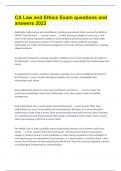Exam (elaborations)
CA Law and Ethics Exam questions and answers 2023.
- Course
- Institution
Applicable California law and a practitioner's professional code of ethics (such as the NASW or CAMFT Code of Ethics) ... ... do NOT hold equal weight in court cases. Only some of the ethical standards outlined in the professional ethical standards are enforceable guidelines for professional condu...
[Show more]



